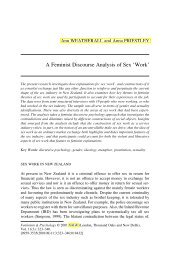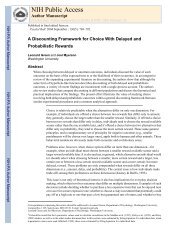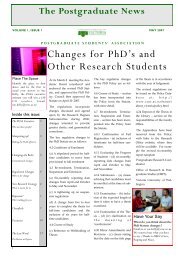Perner 2010.pdf
Perner 2010.pdf
Perner 2010.pdf
You also want an ePaper? Increase the reach of your titles
YUMPU automatically turns print PDFs into web optimized ePapers that Google loves.
Page 252252 <strong>Perner</strong>Do precocious signs of understanding belief meetPovinelli’s Challenge?The meta-analysis by Wellman et al. (2001) showed that despite manyattempts to demonstrate understanding false belief before the age of 4 years,no factor emerged that could reliably achieve this. Single studies reportinglarger proportions of successful younger children appeared to be ephemeralblips. Only the results from using indirect measures of understanding(Clements & <strong>Perner</strong>, 1994) have been replicated on a larger scale after publicationof the meta-analysis. Signs of appreciating false belief appear reliably ina majority of children at or just before the age of 3 years. In the basic set-up,the story protagonist disappears and returns via one of two doors. Thisallows checking on children’s expectations of where the protagonist willreturn by recording their eye gaze. And, indeed, a majority of 3-year-oldslook at the door next to the location where the protagonist thinks his objectis, while almost all of them predict, when asked, that he will reappear at theother door near where the object actually is. This admittedly curious findinghas been securely replicated (e.g., Garnham & <strong>Perner</strong>, 2001; Garnham &Ruffman, 2001; Low, 2007; Ruffman, Garnham, Import, & Connolly, 2001).Moreover, when the object in question disappears from the scene, a similarfinding has been reported in children as young as 2 years (Southgate, Senju, &Csibra, 2007), 13 or even younger (Southgate 2008).Another group of studies claimed even earlier sensitivity to false beliefusing looking time as the dependent measure. The duration of looking at anerroneous action is compared to looking at a successful action. Longer lookingat the successful action than at the erroneous action in cases of false beliefis interpreted as children being surprised about a successful action when theactor has a false belief. These data indicate sensitivity to the protagonist’sbelief as early as 14 or 15 months (Onishi & Baillargeon 2005; Surian, Caldi,& Sperber, 2007). One problem with these data is that the looking-time differencesare multiply interpretable and not a clear indicator of expectation(<strong>Perner</strong> & Ruffman 2005; Sirois & Jackson, 2007). Here I just want to pointout that the looking-time differences 14 and the looking in expectation can beexplained by the use of behavior rules (SA-CIPs).Two features help defend this explanation. (1) The measures employed areall indirect tests 15 as opposed to the direct tests of belief-based behavior in thetraditional false-belief tests. This can explain why 3-year-old children look atthe point of reappearance where the protagonist thinks the object is whereas,when asked, they steadfastly claim that he will reappear from the door nearwhere the object actually is. This is in analogy to implicit memory. Havingseen a word on a list can make it demonstrably more likely to find it as asolution to an anagram (indirect test) even when there is complete failure ofidentifying the word as a member of the list on a (direct) recognition test. (2)These original demonstrations of precocious sensitivity use a quite narrowrange of both belief-inducing situations and response demands – that is,NOT FOR DISTRIBUTIONPerception, attention, and action:International Perspectives on Psychological Science (Volume1). Peter A. Frensch and Ralf Schwarzer (Eds). 2010.Published by Psychology Press on behalf of the International Union of Psychological Science.This proof is for the use of the author only. Any substantial or systematic reproduction,re-distribution, re-selling, loan or sub-licensing, systematic supply or distribution in anyform to anyone is expressly forbidden.15:58:17:03:10Page 252






